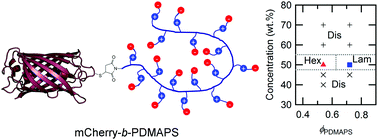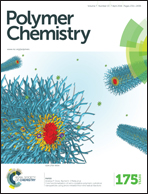Self-assembly of protein-zwitterionic polymer bioconjugates into nanostructured materials†
Abstract
The microphase separation of a bioconjugate made of a globular protein and a zwitterionic polymer is studied in order to elucidate the role of charge in the polymer block on the self-assembly of protein–polymer bioconjugates. Zwitterionic polymer surfaces are resistant to nonspecific protein adsoprtion due to strong hydration; however, bioconjugates constructed from a red fluorescent protein, mCherry, and a zwitterionic polymer, PDMAPS, show a relatively narrow range of conditions for self-assembly in concentrated systems. The bioconjugates demonstrate weaker segregation strengths compared to previously studied mCherry–polymer conjugates with non-ionic polymers, as demonstrated by higher order-disorder transition concentrations (CODT) and a narrower range of ordered concentrations in the phase diagram. The results suggest that electrostatic segregation of mCherry is one of the main parameters governing the self-assembly of protein–nonionic polymer bioconjugates, and this driving force is perturbed by the zwitterionic polymer. Disruption of ordering upon addition of NaCl confirms that electrostatics play a critical role in the bioconjugate self-assembly. Order–disorder–order transitions are observed with increasing concentration of a kosmotropic salt, ammonium sulphate, due to the initial salt-in followed by salt-out effect, suggesting that stabilization of protein domains by enhancing attractive interactions between proteins can significantly improve long range ordering.


 Please wait while we load your content...
Please wait while we load your content...